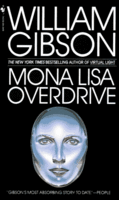 Mona Lisa Overdrive is the last in the sprawl trinity that made William Gibson famous. It follows Neuromancer and Count Zero. Like his other novels it plays with reality and virtual reality or “cyberspace” (the word Gibson coined.) The title character is vintage Gibson, a smart street girl who is picked up and altered to look like a star so that her body can be used in a kidnapping. In the end Mona Lisa replaces the star when she goes virtual (into the aleph, a biochip holding the/a world) and then takes off to meet another distant alien AI she might marry(?). It is a very old form of swapped reality, the peasant and king trading places. There are other ways Gibson plays with the varieties of altered reality. One character, the young daughter of a Japanese ganster, has a digital ghost only she can see who comforts and advises her. Another character builds robotic sculpture to exorcise his penal ghosts. Gibson is reminding of all the virtualities, including that enigmatic painted smile by Leonardo.
Mona Lisa Overdrive is the last in the sprawl trinity that made William Gibson famous. It follows Neuromancer and Count Zero. Like his other novels it plays with reality and virtual reality or “cyberspace” (the word Gibson coined.) The title character is vintage Gibson, a smart street girl who is picked up and altered to look like a star so that her body can be used in a kidnapping. In the end Mona Lisa replaces the star when she goes virtual (into the aleph, a biochip holding the/a world) and then takes off to meet another distant alien AI she might marry(?). It is a very old form of swapped reality, the peasant and king trading places. There are other ways Gibson plays with the varieties of altered reality. One character, the young daughter of a Japanese ganster, has a digital ghost only she can see who comforts and advises her. Another character builds robotic sculpture to exorcise his penal ghosts. Gibson is reminding of all the virtualities, including that enigmatic painted smile by Leonardo.
What seems to be the digitized version of a slightly different version can be found at, William Gibson – Mona Lisa Overdrive. It doesn’t match my paperback copy – I wonder what the difference is?
Of interest to the digital version is the “Afterword” where Gibson talks about his history of writing technology from typewriters to Powerbooks and how they end up in a closet, abandoned.
But Neuromancer and its two sequels are not about computers. They may
pretend, at times, and often rather badly, to be about computers, but really
they’re about technology in some broader sense. Personally, I suspect they’re
actually about Industrial Culture; about what we do with machines, what machines
do with us, and how wholly unconscious (and usually unlegislated) this process
has been, is, and will be. Had I actually known a great deal (by 1981 standards)
about real computing, I doubt very much I would (or could) have written
Neuromancer . Perhaps it all goes to prove that there are situations (literary
ones, at least) in which a little knowledge is not only a dangerous thing, but
the best tool for the job at hand.
But I confess it gives me greater pleasure still, to contemplate that
process whereby every tech, however sharp this morning, is invariably supplanted
by the new, the unthinkable, and to imagine these words, unread and finally
inaccessible, gathering dust at the back of some drawer in some year far up the
road. Nothing in there but a tarnished Yale key, a silver dime, a couple of
desiccated moths, and several hundred thousand data-compressed words, all in a
row.I know; I put them there.